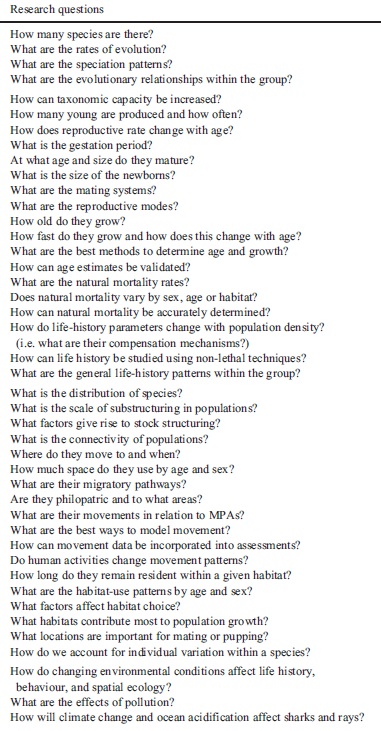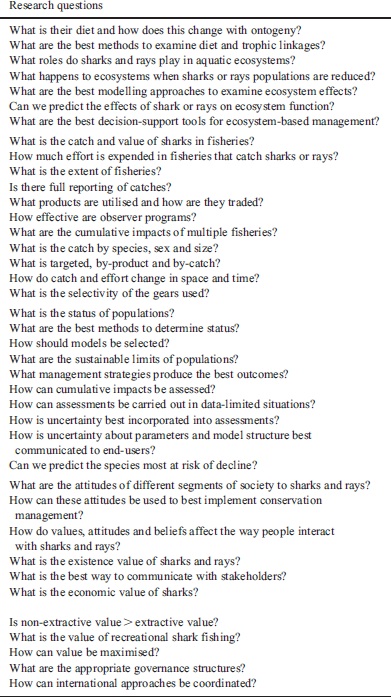
“There are known knowns; there are things we know we know. We also know there are known unknowns, that is to say we know there are some things we do not know. But there are also unknown unknowns – the ones we don’t know we don’t know.” – Former U.S. Secretary of Defense Donald Rumsfeld.
As nature documentary viewers often hear, there is a lot about sharks and rays that scientists don’t know… but what are the most important things that we need to know? A new paper written by Colin Simpfendorfer, Will White, and former Shark Science Monday interview subjects Michelle Heupel and Nick Dulvy attempts to identify these “known unknowns” of shark and ray conservation. “The importance of research and public opinion to conservation management of sharks and rays: a synthesis”, which arose out of the 2010 Sharks International conference, is the most complete record ever created of the research questions that we need to answer in order to better conserve and manage these animals. For young shark researchers eager to work on projects with practical conservation importance, this paper is a great place to start looking for ideas. Additionally, future published work that claims to be important for conservation and management would do well to cite it, and anyone interested in this subject should read it.
This new paper contains a thorough description of pressing research needs for shark conservation, as well as a table (reproduced below in its entirety) listing important research questions. The long list of more than 80 research questions may appear daunting. However, don’t despair! All this means is that no one researcher or technique can get the data we need to save sharks and rays.
The future of these animals will depend, as it always has, on a large number of people working on many different projects; people who share a common goal and often work together, but who each focus on a different piece of the puzzle. I am happy to report that there are indeed many smart, passionate people all over the world working to address most of these questions. In many cases, a single research project can focus on many of them- for example my Masters thesis addressed 3 of these research questions for sandbar sharks, and my Ph.D. dissertation has the potential to help resolve as many as 15 for certain species.
For their excellent contribution to shark and ray conservation, I am pleased to announce that I am awarding this paper and it’s authors the first annual WhySharksMatter “Most Important Shark Conservation Paper of the Year” award! Congratulations to Colin, Will, Michelle, and Nick! The award comes with a certificate and a beer the next time I see you at a conference!
As for the rest of our readers, I have a challenge for you: Look through this table and see if you can think of a single important research question that isn’t included in some form or another. I sure can’t think of very many.


For those who would like to read the paper it is available free at the Amrine and Freshwater Research website:
http://www.publish.csiro.au/paper/MF11086.htm
The entire Sharks International special issue is Open Access. You can find the contents page here:
http://www.publish.csiro.au/nid/127/issue/5632.htm
A great paper Colin–has provided a platform for our ongoing and future research.
Time to know what we know. Those are fascinating questions. Here is one answer to the problems of Shark Conservation: make more marine protected areas and corridors. This recent article from Costa Rica is like Saving Sharks 101. You could see it here:
http://www.ticotimes.net/Opinion/Previous-perspectives/Sharks-Are-Our-Friends-Let-s-Protect-Them
Viva Sharks!
Shawn Larkin
Great paper, certainly plenty of work to be done! As my BSc dissertation I am investigating the knowledge, attitudes and fishing practices with regard to shark in UK recreational anglers. I will certainly be citing this paper and some of the others from the conference.
Great list and great paper! I am by no means an authority yet, but recent research seems to suggest social dynamics for some species, therefore, what are these, to which species do these apply, and what happens when these are disturbed.
What recent research are you referring to, Jeanette?
There was a show recently on NGC where they were saying they believe whites are not believed to be as solitary as once thought, but it was kind of open-ended, as is this just behavior during a feeding event or is this a coming together when they are migrating TO feeding events with the resulting social implications. What caused them to make that statement I don’t know. But last year I came across some papers when I was searching for info on their preferred depths for migration…I just remember it because the whole idea of it caught my attention….I will dig for those papers because I find the whole idea interesting,and I will get back to you on that with the references.